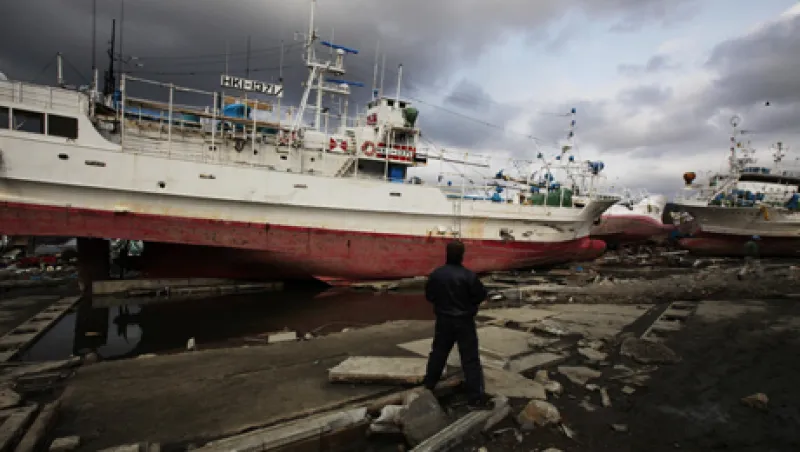If the world seems more dangerous — buffeted more than before by natural and human-caused disasters, severe weather, political unrest and financial instability — it is no illusion. Catastrophes are on the rise, and experts say the trend is neither temporary nor coincidental. “I call it the new risk architecture,” says Erwann Michel-Kerjan, a professor at the University of Pennsylvania’s Wharton School and co-leader of Wharton’s Risk Management and Decision Processes Center. “Like it or not, it is reality.”
Are things really that much worse today than they have been historically? Or are they magnified on a planet shrunk by globalization and mass media? There are empirical measures, to be sure, but perceptions matter, and they are evolving.
The reality? Damaging earthquakes, as recorded in the Catdat database at Australia’s University of Adelaide, increased from 96 in 2010 to at least 121 in 2011. Several of the 2011 events caused multibillion-dollar losses, but none came close to Japan’s 9.0 Tohoku quake of March 11, the most expensive of all time, with economic costs upward of $300 billion.
Another indicator, from Zurich-¬based Swiss Re: Insurance claims from natural and man-made catastrophes in 2011 — the year after that of the Haitian earthquake and the Deepwater Horizon oil spill in the Gulf of Mexico — more than doubled, to $108 billion. The claims would have been far greater if Japan had been more fully insured.
The media coverage and financial effects of the Japanese earthquake and the tsunami it triggered continue to weigh heavily on the consciousness of public and private sector officials. And thus, notes Wharton’s Michel-¬Kerjan, there is a growing realization among decision makers that rare and extreme risk events — once discounted, if not ignored, as improbable “black swans” — have to be planned for. An earthquake in Japan or a volcanic eruption in Iceland, as happened in 2010, disrupts commerce and transportation, and demonstrates how “risks are global and interconnected,” Michel-Kerjan adds.
That notion of interconnectedness leads to a still-bigger-picture assessment of exposures, which may have been captured and catalogued most comprehensively in the annual reports that the Geneva-based World Economic Forum has been producing since 2005. As a barometer of the state of the world, the Global Risks series — with Swiss Re and Wharton among the leading study participants — has projected a progressively heightened sense of alarm.
The sixth edition, published in January 2011, opened this way: “The world is in no position to face major, new shocks.” It went on to warn of “ever-greater concerns” and, critically, “the prospect of rapid contagion through increasingly interconnected systems and the threat of disastrous impacts.”
“Global Risks 2012,” which came out last month ahead of the WEF gathering of elites in Davos, does not try to top those prophetic words. Instead, it “emphasizes the singular effect of a particular constellation of global risks, rather than focusing on a single existential risk,” says the executive summary. A “quantitative analysis of interconnections” among 50 identified risks — economic, environmental, geopolitical, societal and technological — yielded three cluster scenarios: “seeds of dystopia” (economic decline and dysfunctional governance), “how safe are our safeguards?” (breakdowns in policy and regulatory protections) and “the dark side of connectivity” (technology and cyberthreats).
The report “illustrates how more volatile and interdependent the world is becoming,” says Michel-Kerjan. But the flip side of extreme losses, he contends, is “extreme benefits” from effective, forward-looking risk management. The Wharton professor says he is encouraged to see more corporations recognizing risk and “going into active mode.” Boards of directors are “having frank discussions of global catastrophic risks and asking, ‘Are we really prepared?’”
Indeed, preparedness is the answer to uncertainty. Gordon Woo, a consultant with Risk Management Solutions of Newark, California, and author of the 2011 book Calculating Catastrophe, says that although earthquakes are not predictable, through “operational earthquake forecasting” responses can be devised and the public educated so that the risks and damages are mitigated.
Financial crashes and other man-made catastrophes are not so different, in Woo’s view. There is a common “calculational framework,” he writes, “which makes a knowledge of natural hazards relevant for those aspiring to deepen their understanding of man-made hazards and to lessen the degree of surprise they may cause.” • •
Jeffrey Kutler is editor-in-chief of Risk Professional magazine, published by the Global Association of Risk Professionals.






